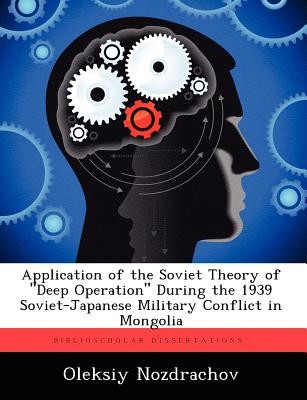
- We will send in 10–14 business days.
- Author: Oleksiy Nozdrachov
- Publisher: BiblioScholar
- ISBN-10: 1249363322
- ISBN-13: 9781249363323
- Format: 18.9 x 24.6 x 0.6 cm, softcover
- Language: English
- SAVE -10% with code: EXTRA
Application of the Soviet Theory of Deep Operation During the 1939 Soviet-Japanese Military Conflict in Mongolia (e-book) (used book) | bookbook.eu
Reviews
Description
During the Interwar period, the Soviet theory of "deep operations," like Soviet military science as a whole developed in parallel with Soviet armed forces organizational reform, including rearmament and preparation for current threats. The determining factors which created favorable conditions for the emergence of the theory were rearmament and reorganization of the Red Army and the combat experience of previous wars of 20th century. However, Stalin's 1937-1940 repression impeded the development and application of the theory. At the same time in the Far East, a full-scale undeclared war developed between Japan and the Soviet Union. The 1939 war became the real battlefield for examining the Red Army, its capability to deploy combined joint forces, to organize comprehensive combat and logistic support of its troops, and to coordinate the efforts with the Mongolian People's Army. The 1939 military conflict in the Far East demonstrated the growth of the Soviet theory of the "deep operation," as well as the leadership talents of General Georgi Konstantinovich Zhukov. This thesis explores aspects of the "deep operation" development and its application during the 1939 Soviet-Japanese military conflict in Mongolia.
EXTRA 10 % discount with code: EXTRA
The promotion ends in 17d.07:41:37
The discount code is valid when purchasing from 10 €. Discounts do not stack.
- Author: Oleksiy Nozdrachov
- Publisher: BiblioScholar
- ISBN-10: 1249363322
- ISBN-13: 9781249363323
- Format: 18.9 x 24.6 x 0.6 cm, softcover
- Language: English English
During the Interwar period, the Soviet theory of "deep operations," like Soviet military science as a whole developed in parallel with Soviet armed forces organizational reform, including rearmament and preparation for current threats. The determining factors which created favorable conditions for the emergence of the theory were rearmament and reorganization of the Red Army and the combat experience of previous wars of 20th century. However, Stalin's 1937-1940 repression impeded the development and application of the theory. At the same time in the Far East, a full-scale undeclared war developed between Japan and the Soviet Union. The 1939 war became the real battlefield for examining the Red Army, its capability to deploy combined joint forces, to organize comprehensive combat and logistic support of its troops, and to coordinate the efforts with the Mongolian People's Army. The 1939 military conflict in the Far East demonstrated the growth of the Soviet theory of the "deep operation," as well as the leadership talents of General Georgi Konstantinovich Zhukov. This thesis explores aspects of the "deep operation" development and its application during the 1939 Soviet-Japanese military conflict in Mongolia.


Reviews